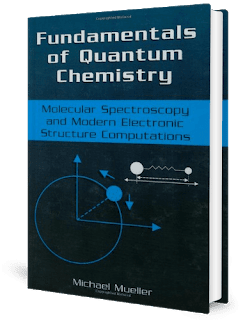| Book Name: | [PDF] Fundamentals of Quantum Chemistry – Molecular Spectroscopy and Modern Electronic Structure Computations by Michael Mueller |
| Category: | Quantum Chemistry |
| Free Download: | Available |
Fundamentals of Quantum Chemistry – Molecular Spectroscopy and Modern Electronic Structure Computations by Michael Mueller :: This text is designed as a practical introduction to quantum chemistry for undergraduate and graduate students. The text requires a student to have completed a year of calculus, a physics course in mechanics, and a minimum of a year of chemistry. Since the text does not require an extensive background in chemistry, it is applicable to a wide variety of students with the aforementioned background; however, the primary target of this text is for undergraduate chemistry majors. The text provides students with a strong foundation in the principles, formulations, and applications of quantum mechanics in chemistry. For some students, this is a terminal course in quantum chemistry providing them with a basic introduction to quantum theory and problem solving techniques along with the skills to do electronic structure calculations – an application that is becoming increasingly more prevalent in all disciplines of chemistry. For students who will take more advanced courses in quantum chemistry in either their undergraduate or graduate program, this text will provide a solid foundation that they can build further knowledge from. Early in the text, the fundamentals of quantum mechanics are established.
This is done in a way so that students see the relevance of quantum mechanics to chemistry throughout the development of quantum theory through special boxes entitled Chemical Connection. The questions in these boxes provide an excellent basis for discussion in or out of the classroom while providing the student with insight as to how these concepts will be used later in the text when chemical models are actually developed. Students are also guided into thinking “quantum mechanically” early in the text through conceptual questions in boxes entitled Points of Further Understanding. Like the questions in the Chemical Connection boxes, these questions provide an excellent basis for discussion in or out of the classroom. These questions move students from just focusing on the rigorous mathematical derivations and help them begin to visualize the implications of quantum mechanics. Rotational and vibrational spectroscopy of molecules is discussed in the text as early as possible to provide an application of quantum mechanics to chemistry using model problems developed previously. Spectroscopy provides for a means of demonstrating how quantum mechanics can be used to explain and predict experimental observation. The last chapter of the text focuses on the understanding and the approach to doing modern day electronic structure computations of molecules. These types of computations have become invaluable tools in modern theoretical and experimental chemical research. The computational methods are discussed along with the results compared to experiment when possible to aide in making sound decisions as to what type of Hamiltonian and basis set that should be used, and it provides a basis for using computational strategies based on desired reliability to make computations as efficient as possible.

| Title: | Fundamentals of Quantum Chemistry – Molecular Spectroscopy and Modern Electronic Structure Computations |
| Editor: | Michael Mueller |
| Edition: | 1st |
| Publisher: | Wolters Kluwer |
| Length: | 280 pages |
| Size: | 5.95 MB |
| Language: | English |
Fundamentals of Quantum Chemistry: Molecular Spectroscopy and Modern Electronic Structure Computations
Author(s): Michael P. Mueller
Publisher: Springer, Year: 2001
ISBN: 0306465965









![[PDF] Draw Buildings and Cities in 15 Minutes Draw Buildings and Cities in 15 Minutes pdf](https://www.freepdfbook.com/wp-content/uploads/2021/06/Draw-Buildings-and-Cities-in-15-Minutes-218x150.jpg)








![[PDF] Digital Image Processing An Algorithmic Introduction Using Java Digital Image Processing An Algorithmic Introduction Using Java](https://www.freepdfbook.com/wp-content/uploads/2022/06/Digital-Image-Processing-An-Algorithmic-Introduction-Using-Java.jpg)




![[PDF] 43 Years JEE ADVANCED + JEE MAIN Chapterwise & Topicwise Solved Papers 43 Years JEE ADVANCED (1978-2020) + JEE MAIN Chapterwise & Topicwise Solved Papers Physics PDF](https://www.freepdfbook.com/wp-content/uploads/2022/03/43-Years-JEE-ADVANCED-1978-2020.jpg)

![[PDF] Problems in Physical Chemistry for JEE (Main & Advanced) Problems in Physical Chemistry for JEE (Main & Advanced) Free PDF Book Download](https://www.freepdfbook.com/wp-content/uploads/2022/03/Problems-in-Physical-Chemistry-for-JEE-Main-Advanced.jpg)
![[PDF] Engineering Physics (McGraw Hill)](https://www.freepdfbook.com/wp-content/uploads/2021/05/bafc8c2685bb6823a9c56134f7fba5df.jpeg)

![[PDF] Engineering Chemistry By Shashi Chawla](https://www.freepdfbook.com/wp-content/uploads/2022/05/Theory-And-Practicals-of-Engineering-Chemistry-By-Shashi-Chawla-free-pdf-book.jpeg)
![[PDF] Chemistry: An Introduction to Organic, Inorganic & Physical Chemistry Chemistry: An Introduction to Organic, Inorganic & Physical Chemistry](https://www.freepdfbook.com/wp-content/uploads/2022/04/Chemistry-An-Introduction-to-Organic-Inorganic-Physical-Chemistry.jpg)
![[PDF] Essentials of Physical Chemistry Essentials of Physical Chemistry Free PDF Book by Bahl](https://www.freepdfbook.com/wp-content/uploads/2022/04/Essentials-of-Physical-Chemistry-bahl.jpg)
![[PDF] Biological control of plant-parasitic nematodes: soil ecosystem management in sustainable agriculture Biological control of plant-parasitic nematodes: soil ecosystem management in sustainable agriculture](https://www.freepdfbook.com/wp-content/uploads/2022/05/Biological-control-of-plant-parasitic-nematodes-soil-ecosystem-management-in-sustainable-agriculture.jpg)
![[PDF] Human Anatomy: Color Atlas and Textbook Human Anatomy: Color Atlas and Textbook Free PDF Book](https://www.freepdfbook.com/wp-content/uploads/2022/05/Human-Anatomy-Color-Atlas-and-Textbook.jpg)
![[PDF] Concepts of Biology Book [Free Download]](https://www.freepdfbook.com/wp-content/uploads/2022/05/Concepts-of-Biology.jpg)
![[PDF] Essentials of Biology [Free Download] Essentials of Biology Free PDF BOok Download](https://www.freepdfbook.com/wp-content/uploads/2022/05/Essentials-of-Biology-Free-PDF-Book-Downlaod.jpg)
![[PDF] Human Biology Book [Free Download]](https://www.freepdfbook.com/wp-content/uploads/2022/05/PDF-Human-Biology-Book-Free-Download.jpg)